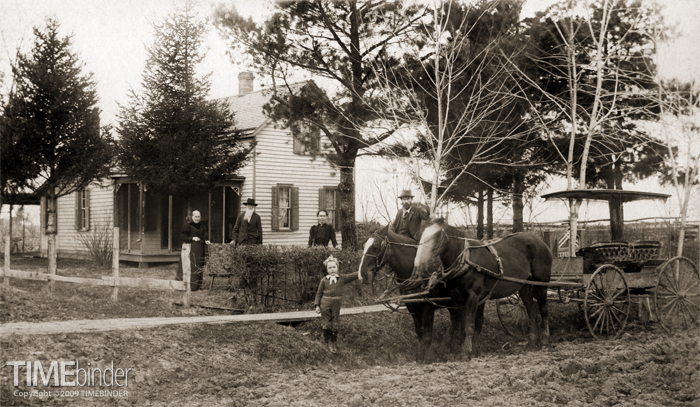
Here is a particularly charming example of what I call the “our place” genre of family photos. For such a tiny house, it has large house pretensions: a bay window, dormers, a mansard/gambrel style roof and two chimneys. It appears to sit on an insubstantial foundation – almost directly on the ground – which gives it an almost toy-like appearance, like someone just left it in the yard after they were through playing with it!
Does the elder gentleman own the house or is he just taking charge of the photo process; he sports a mutton chop beard and may hold a large, curved German-style briar pipe in his hand? The son and retiring daughter-in-law (we assume) stand in the background, but the daughters steal the show – they have chosen to climb out of the window onto the tiny roof to display a family cat and a doll! They are such sweet, smiling little misses, one brunette and one blond, that I will give you a close up to enjoy. I also enjoy the wife who stands with her arms folded behind her, watching with intent curiosity (her daughters may be very like her); this photo may not have been her idea but it may have survived in her care. Everything about this photo gives you the feeling that this would be a pleasant family to know and the girls are enjoying a happy childhood. I hope you enjoy it as much as I have.
I believe this is 19th century, as early as 1870s, but could also be early 20th century; the seller found it in Oregon and had reason to believe the family was from San Jose, CA. Though there are few leaves on the trees there are none on the ground, so it may be early Spring rather than late Fall. I can tell little about the nature of the structures and sheds on the left, but there is a large pickle or sauerkraut crock next to the broom by the kitchen door. The rickety fence is clad in chicken wire but I see no chickens here. Do they farm for a living, or like many, does he hold another job and supplement the food supply with gardens and a few animals?
Are we being unseemly curious about the affairs and circumstances of past lives when we look at photos? I’m sure most of the people in them might be puzzled by the kinds of questions we ask. By their very purpose, photos are to be looked at, so what are we to do, just stare and have no reactions or questions? Not I!
This is a large cabinet print that is in relatively good condition with the exception of a series of fine cracks in the glossy emulsion that radiate like shattered glass – something I have never seen before. Sorry, but I have to ask: couldn’t the photographer have moved a bit to the left or the right so the tree was not the most prominent feature?

 Thursday, August 27, 2009 at 6:41PM
Thursday, August 27, 2009 at 6:41PM 
 OUR PLACE
OUR PLACE 








